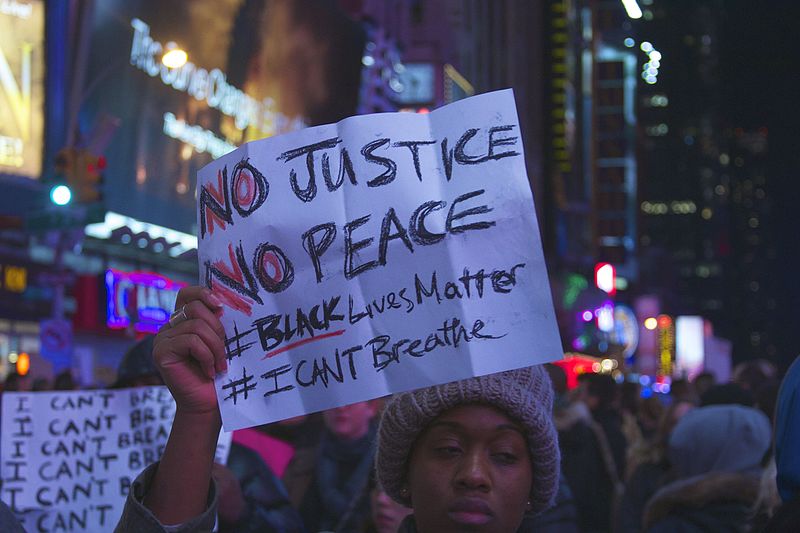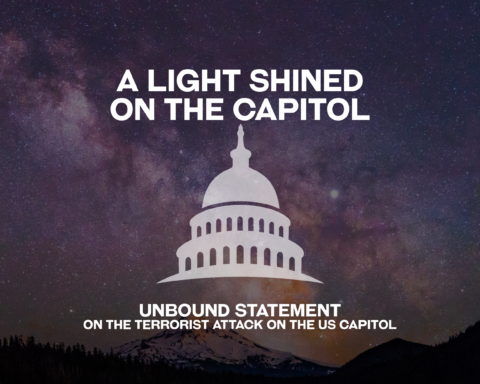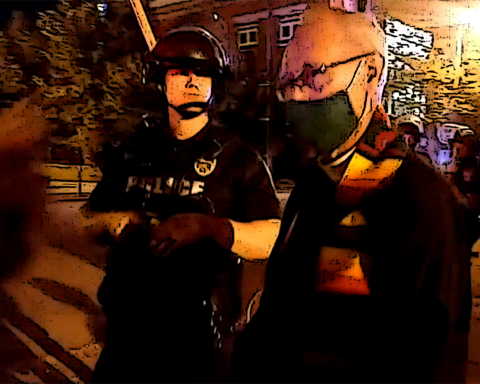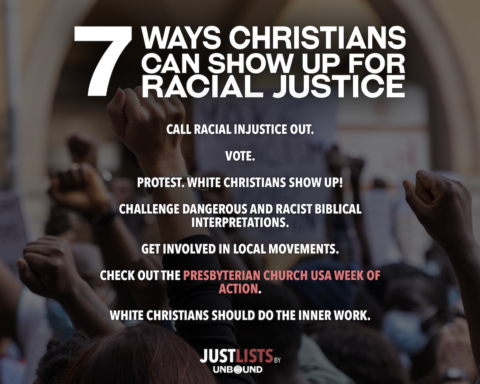
If I remember correctly, the classroom in Tennent Hall had a half moon window. I can still see the faces gathered around the table that day in 1992, still feel the familiar, smooth feel of a laminated church tabletop beneath my fingers. We were on the second floor, so we could see the partly cloudy sky above Roberts Hall. On this day we came in a bit more reserved than usual. Interesting, you see, that we would be discussing The Transfiguration of Politics: Jesus Christ and the Question of Revolution, by Paul Lehmann, the day after the LA riots following the Rodney King verdict.
In March of 1991, Rodney King was severely beaten by four police officers, and someone used a video camera to film part of the beating. The verdict, which came over a year later in April of 1992, was that the four officers were not guilty. “Jurors were not convinced that an 81-second videotape of the incident represented the entire story.”
For class that day, we had read the section of Lehmann’s book titled “From Franz Fanon to Martin Luther King, Jr., Malcom X, and the Black Panther Party” in which he offers readers the lens of humanization, revolutions being a clear sign that human experience has changed from cramped to unjust. Story functions with particular power, since it “refers to the way in which one generation tells another how the future shapes the present out of the past (p. 7).” In which case, of course, the “entire story” the jurors indicated started way before Rodney King was pulled from his car and beaten.
A Revolution that is “Fair and Beautiful”?
The word “revolution” has surfaced within wildly different political affiliations this election cycle, which is worth paying attention to. Lehmann’s point in this richly dense book is to posit Jesus Christ, who enters the human story, as the one who can shape the “passion for humanization that generates revolution” in a sustaining, life-giving way.
 I have been intrigued by the concept of revolution for a long time, beginning with my childhood realization that the British soldiers had marched down the middle of colonial streets in red uniforms in the revolution that gave birth to the United States. Even then, four decades before I would read The Art of War, I could see that was a mighty silly strategy, in retrospect. Through years of high school, college, and seminary, I began to see that strategy, while fascinating on its own, is not really something to keep around for it’s own sake. William Morris would want us to assess whether it is useful or beautiful. On its own, it is not.
I have been intrigued by the concept of revolution for a long time, beginning with my childhood realization that the British soldiers had marched down the middle of colonial streets in red uniforms in the revolution that gave birth to the United States. Even then, four decades before I would read The Art of War, I could see that was a mighty silly strategy, in retrospect. Through years of high school, college, and seminary, I began to see that strategy, while fascinating on its own, is not really something to keep around for it’s own sake. William Morris would want us to assess whether it is useful or beautiful. On its own, it is not.
Right? Strategy is best developed in context; it can only be useful or beautiful as one proceeds toward the goal. The beauty of red coats became irrelevant as they continued to be useless to the British. How a revolution transpires – and I have read articles about revolution being called for at Trump, Clinton, and Sanders rallies – depends on a strategy. A useful strategy gets things done.
What about a useful strategy in a revolution that might also be beautiful? What does a revolution of justice look like? According to Lehmann, human and biblical politics coincide when they:
“express the characteristic will and purpose of God, according to which the Creator and Redeemer of the world brings the world, and all things in it, to their appointed and freeing fulfillment. The will and purpose of God are that the creature who, as male and female, bears God’s likeness and singular favor, shall find in privacy and in society the fulfilling joy of reciprocal creaturehood and creativity.” (p. 233. emphasis mine)
That sounds fair.
In fact, it sounds fair in all senses of the word. Fair means parts arranged in a pleasing whole, thus connoting beauty and community festivals as well as justice. Politics are “fair” when policies and actions are arranged in a pleasing whole; in this case, when human beings find “the fulfilling joy of reciprocal creaturehood and creativity” in daily life. For example, the revolutionary strategies used to move from the enslavement of black bodies through the brutality on (against) black bodies that we see regularly in our news today to a context in which bodies of color find with all others “the fulfilling joy of reciprocal creaturehood and creativity” need to be useful and beautiful strategies.
 Lehmann, explicitly, wants us to see revolutions and the violence that often comes with them in the context of our Christian story: The incarnation. Because we believe Jesus of Nazareth is God with us, in the flesh, and has entered human history, we have to look for where God is working in distressing situations.
Lehmann, explicitly, wants us to see revolutions and the violence that often comes with them in the context of our Christian story: The incarnation. Because we believe Jesus of Nazareth is God with us, in the flesh, and has entered human history, we have to look for where God is working in distressing situations.
This was startling to me the first time I read Lehmann. I couldn’t conceive of how violence could be indicative of God’s work; wasn’t that just flat out wrong? However, with some time and teaching, I realized the story lens through which I was looking was the wrong one. I was interpreting God’s action in the world through the story lens of civil law rather than the story lens of Scripture – including the Old Testament prophets and the teachings of Jesus. In these foundations of our faith, God’s work is repeatedly the work of justice and righteousness of entire communities, of the vulnerable (widows, orphans, strangers, the imprisoned, the sick, the starving, the thirsty, the naked, the homeless) and the strong in reciprocal fulfilling joy.
“That’s not fair!” someone cries. “Well, life isn’t fair,” someone else responds. But it’s supposed to be, according to Scripture. Indeed, if our narrative begins in Genesis with God seeing God’s creation as good, we are called through law and prophets to aim in our daily actions for a community fitting well together, a fair community, a community of justice, of reciprocal, fulfilling joy.
Reciprocal Creaturehood and the Brutalization of Black Bodies
The cries we have been hearing are that life is far from fair – ugly, in fact, for so many, and not beautiful at all. No fulfilling joy in reciprocal creaturehood. Poverty is ugly, with entire parts missing, let alone the ones that exist not fitting together. Violence toward people of color at traffic stops is ugly, too, as parts of one human being destroy the parts of other human beings. Nothing beautiful at all: it’s indecent and disorderly when a busted taillight results in death, or when the possession of Skittles ends likewise.

In the popular new Marvel series for Netflix, Luke Cage’s black body is brutalized over and over again in the midst of his black community. The television series takes us into this community in Harlem where one of the many dynamics is that between the police and the citizens, a dynamic creating constant fear. It is significant that the titular hero walks around, bulletproof, in a black hoodie (that is always full of holes). It’s a nicely layered series, with a good story arc and myriad cultural references. And if we pay close attention, we can see the foil that ugliness can provide for beauty.
Because the violence is ugly. It’s bloody and it’s pervasive and it is not cushioned at all. But it can’t be taken at face value or isolated from its context, not if we want to understand the why of it. The context of this superhero story is a revolution of sorts, people revolting against the powers that be which threaten their daily existence. Anthea Butler named the reality clearly and unflinchingly at the recent DisGrace Conference at Montreat: she might be a professor at U Penn, but as soon as she leaves campus, she’s just another black woman on the streets of Philadelphia. Fear for her life means she has to comply with officers’ demands, even as many videos have shown us that compliance can just as easily result in death as noncompliance.
___________________________________________
Whether we’d like to admit it or not, we can easily make the mistake of the Rodney King beating verdict jurors.
___________________________________________
 That this is a real life context only strengthens the show’s premise; what we see on the screen is echoed in the streets and homes of our nation. Set against the real life context, we can see that the basic premise of the Luke Cage story is injustice: a situation which is structured against that “fulfilling joy of reciprocal creaturehood and creativity.” Life is “fair” (that is, beautiful and lovely and most of what we want) for some of us, but only if we ignore the reciprocity to which God in Scripture calls us.
That this is a real life context only strengthens the show’s premise; what we see on the screen is echoed in the streets and homes of our nation. Set against the real life context, we can see that the basic premise of the Luke Cage story is injustice: a situation which is structured against that “fulfilling joy of reciprocal creaturehood and creativity.” Life is “fair” (that is, beautiful and lovely and most of what we want) for some of us, but only if we ignore the reciprocity to which God in Scripture calls us.
If Jesus Christ really has entered the human story – and we Presbyterian Christians affirm that he has – then God is directing our vision to the meaning the incarnation has for all God’s people. Then we can see that Jesus is the one who gives life-sustaining shape to the passion all human beings have for humanization, the passion that drives revolutions erupting in the midst of injustice. The injustice impinges from all sides in Luke Cage, and Luke has to see how all these parts fit together.
What makes this sort of vision of revolutions so tricky is that nothing is clear cut. Human beings are never just one thing. Councilwoman Mariah’s desire for justice – and sometimes Luke’s – is not driven by reciprocity, but she does want the vision of fairness that she can see, even if she’s near-sighted. Luke’s drive is the fulfilling joy of reciprocal creaturehood, but he is also deeply and bitterly hurt by his own loves and losses. It is nearly impossible for us to see how all the parts fit together.
*****
 Whether we’d like to admit it or not, we can easily make the mistake of the Rodney King beating verdict jurors. They didn’t consider that the film of the beating told the entire story, but they missed two things, I think. One is to assume that any “entire story” could justify the beating of someone with completely unnecessary violence (the officers were beating a man who could barely move). The second thing the jurors missed – as so many of us do – is the beginning of the “entire story.” The narration began with Rodney King driving a car as officers chased him, King likely legally drunk at the time. But where does violence start when it is enacted against someone who is no longer driving, who is flat on the ground, barely able to roll over? It has to start somewhere in some other story in which that sort of violence is, at least seemingly, “proportionate.”
Whether we’d like to admit it or not, we can easily make the mistake of the Rodney King beating verdict jurors. They didn’t consider that the film of the beating told the entire story, but they missed two things, I think. One is to assume that any “entire story” could justify the beating of someone with completely unnecessary violence (the officers were beating a man who could barely move). The second thing the jurors missed – as so many of us do – is the beginning of the “entire story.” The narration began with Rodney King driving a car as officers chased him, King likely legally drunk at the time. But where does violence start when it is enacted against someone who is no longer driving, who is flat on the ground, barely able to roll over? It has to start somewhere in some other story in which that sort of violence is, at least seemingly, “proportionate.”
When the verdict came down and the officers were acquitted, the people revolted. There was nothing “reciprocal” about the encounter between the officers and Rodney King, and that is surely also a complicated story that casts a wider net than we can imagine. But so does the revolution that resulted. Why violently protest one verdict…unless something else is already so severely indecent and out of order?
I remember how different I felt crossing the threshold of that Tennent Hall room when I left the seminar than when I had crossed in. What I understood after discussion of Lehmann’s book was that there was so much I didn’t understand about what I had thought I understood just fine. I remember walking back to the library and sitting down in my carrel slowly, cramped as it was and all dull, gray-green metal. I remember the silence.
___________________________________________
The violence is ugly. It’s bloody and it’s pervasive and it is not cushioned at all. But it can’t be taken at face value or isolated from its context, not if we want to understand the why of it.
___________________________________________
My thinking shifted that day, and it hasn’t shifted back. Before that seminar, I had seen revolutionary violence as a violation of civil rules and laws, plain and simple. After that seminar session, my lens was wider. To be honest, this wider lens leaves me in a constant state of discomfort. I can’t see everything through this new lens, but I can see that how we humans live hinders that “fulfilling joy of reciprocal creaturehood and creativity” for which Christ’s presence shapes our passions. I am uncomfortable all the time, often sick at heart, because what I learned in my seminary classroom was that life is not my seminary classroom.
 There is tremendous ethical and theological significance in Dietrich Bonhoeffer’s observation that we cannot will ourselves into existence: we didn’t decide to be born. We come into existence in the middle of stories; revolutions come to light in the middle of stories. #BlackLivesMatter didn’t just pop up out of nowhere. The controversy and protests over the Dakota Access Pipeline didn’t come out of nothing. The internment of Japanese American citizens during World War II was the convergence of a few stories, “[referring] to the way in which one generation tells another how the future shapes the present out of the past (p. 7).”
There is tremendous ethical and theological significance in Dietrich Bonhoeffer’s observation that we cannot will ourselves into existence: we didn’t decide to be born. We come into existence in the middle of stories; revolutions come to light in the middle of stories. #BlackLivesMatter didn’t just pop up out of nowhere. The controversy and protests over the Dakota Access Pipeline didn’t come out of nothing. The internment of Japanese American citizens during World War II was the convergence of a few stories, “[referring] to the way in which one generation tells another how the future shapes the present out of the past (p. 7).”
So how will we tell another generation how the future shapes this present out of the past? It makes all the difference, doesn’t it, what sort of future we envision and what sort of past we acknowledge?
If we imagine Paul Lehmann sitting down with us, having a conversation, he suggests to us this future:
“The will and purpose of God are that the creature who, as male and female, bears God’s likeness and singular favor, shall find in privacy and in society the fulfilling joy of reciprocal creaturehood and creativity.”
 How is our present shaped by this future from a past that has, as part of its own story, the violence against First Nations and the breaking of US treaties with them, the enslavement of African people justified by church-sanctioned racism, the avoidable killing of people of color by police, the violating disruption and scapegoating of lives of Asian Americans?
How is our present shaped by this future from a past that has, as part of its own story, the violence against First Nations and the breaking of US treaties with them, the enslavement of African people justified by church-sanctioned racism, the avoidable killing of people of color by police, the violating disruption and scapegoating of lives of Asian Americans?
What I suggest we do is three things:
sdf
sdf
- We self-consciously recognize that, one way or the other, we are telling a story to others about how the future shapes the present from the past so that we can challenge ourselves about the future we choose and the pasts we don’t
- We learn how to examine the stories we are telling, being rigorous about the degree to which our Christian commitment truly strives for a reciprocal fulfilling joy.
- We recognize that we tell our stories through actions, not beliefs apart from actions, and that we choose, as disciples of Christ, to behave each and every day in such a way that our actions build communities of “fulfilling joy [in] reciprocal creaturehood and creativity.”
_________________________________________
Paul Lehmann, The Transfiguration of Politics: Jesus Christ and the Question of Revolution. Harper & Row Publishers, Inc., New York: 1974.
AUTHOR BIO: Michelle thoroughly enjoys her work as Coordinator of Theological Education and Seminary Relations for the PC(USA). Even more than she enjoys movies, dogs, and dark chocolate. Her theological interests intersect with popular culture, racism, formation, vocation, beauty, and organizations.






Unbound Social